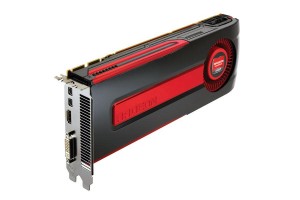Between Nvidia and AMD, the battle for the best high-end graphics card is raging. Having lost ground at the launch of GeForce GTX 600, AMD is back with a reworked map to regain control. The bet is nearly succeeded.
The Radeon HD 7970 GHz Edition is the new benchmark for high-end AMD graphics chip designer. This is the enhanced version of the traditional HD 7970. Since it has a chip clocked at 1000 MHz against 925 MHz for the conventional model. The rest of the technical specifications do not change but AMD provides two new technologies. The first is simply a function of frequency boost of the chip. The other is the power management of the card, touted as more refined and efficient than the previous model.
However, this graphic card seems to released very late in the market and the model is not dual graphics chip expected to face Nvidia’s GeForce GTX 690. In addition, the Radeon HD 7970 GHz Edition will face competition from traditional models of 7970 that ae already over-clocked by Asus, MSI or Sapphire.
The real performance of Radeon HD 7970 GHz Edition:
AMD returns to the front of the stage with its Radeon HD 7970 Edition GHz. Seven months after the release of the Radeon HD 7970 “classic”, the designer has had time to make changes to its benchmark high-end, both the operating frequencies as the energy management. The chip is now operating at 1000 MHz with increasing frequency automatic dynamic (AMD Boost) up to 1050 MHz. The memory is 3 GB of GDDR5 at 3,000 MHz, served by a 384-bit bus allowing 50% more memory bandwidth compared to the GeForce GTX 680, its competitor designated.
AMD is catching up
The HD 7970 GHz Edition displays over 120 images per second on average, on a full HD (1920 x 1080 pixels) with all our usual test sets. If you are lucky enough to own a 30-inch screen (2560 x 1600 pixels), the card is also capable of satisfying the needs of polygons and textures all the latest games in fashion (Battlefield 3 , Spec Ops: The Line , etc..) without sacrificing playability.
With this second version of its flagship, AMD closes the gap left by the GTX 680 from Nvidia. Indeed, the two graphics cards are really neck and neck, although with a small advantage to the GeForce GTX 680 with some of our test sets due to the optimization of certain securities for Nvidia cards.
The Radeon HD 7970 GHz Edition version 2.0 with Boost
Between the two generations of chips 7970, there is real progress. Burning in 28 nm was further improved and the frequency increases highlight the potential of the chip “Tahiti.” Between a map and a 7970 classic 7970 Edition GHz, the second displays between 3 and 20 images of more than the first. Boost function and is no stranger to this difference. When it is triggered, it causes a rise in frequency, which remains active as long as the thermal envelope of graphics processor is not exceeded.
The Radeon HD 7970 GHz Edition High consumption but mastered
To operate at full Boost, so you have a power management as thin as possible. On Radeon cards is AMD Powertune that monitors and refines the energy inputs of the chip for graphics compute it only consumes what it needs. Slightly reworked by AMD for the Radeon HD 7970 Edition GHz, it should also soon benefit other card series Radeon HD 7900.
Not surprisingly, consumption of the card remains quite high despite the benefits of Powertune: 242 watts at full load against 15 watts at idle. For comparison, the GTX 680 from Nvidia does not consume more than 195 watts when fully mobilized and only 12 watts at idle.
That noise!
With such power developed, we expected that AMD reworks on some cooling system of the reference card. Unfortunately, it is not so! This is the same model as the HD 7970 and the first name of it is frankly not discreet. To maintain the chip at the right temperature (83 ° C maximum), the fan runs faster and is therefore a lot of noise.
Conclusion for Radeon HD 7970 GHz Edition
The Radeon Radeon HD 7970 Edition GHz thus allows AMD to catch up with Nvidia and GeForce GTX 680. AMD Boost function and frequency of the chip have been greatly. Both cards are sold at around 500 euros depending on brands. Finally, the Powertune is more effective here than on the Radeon HD 7970 release earlier this year but consumption remains high.
